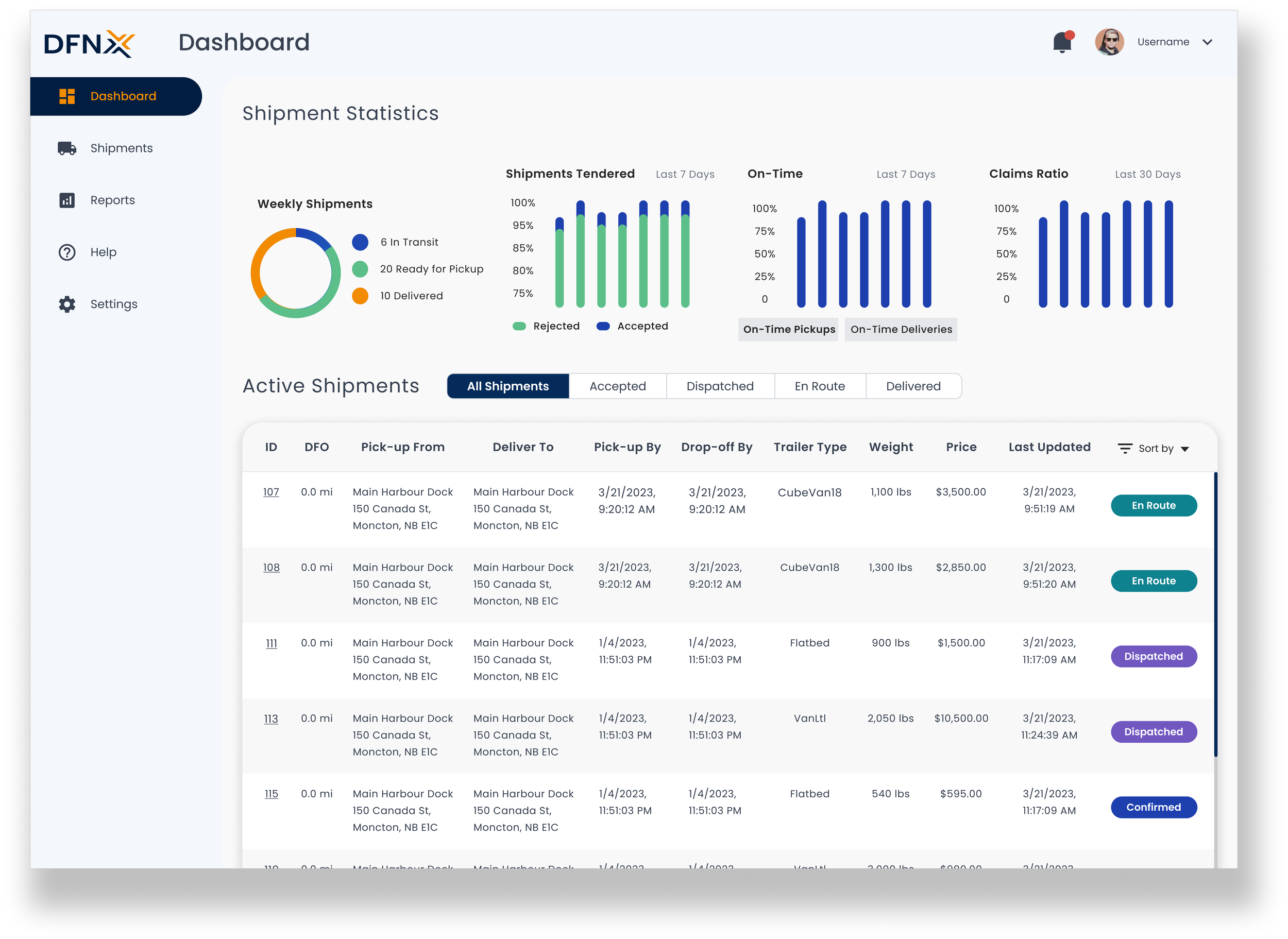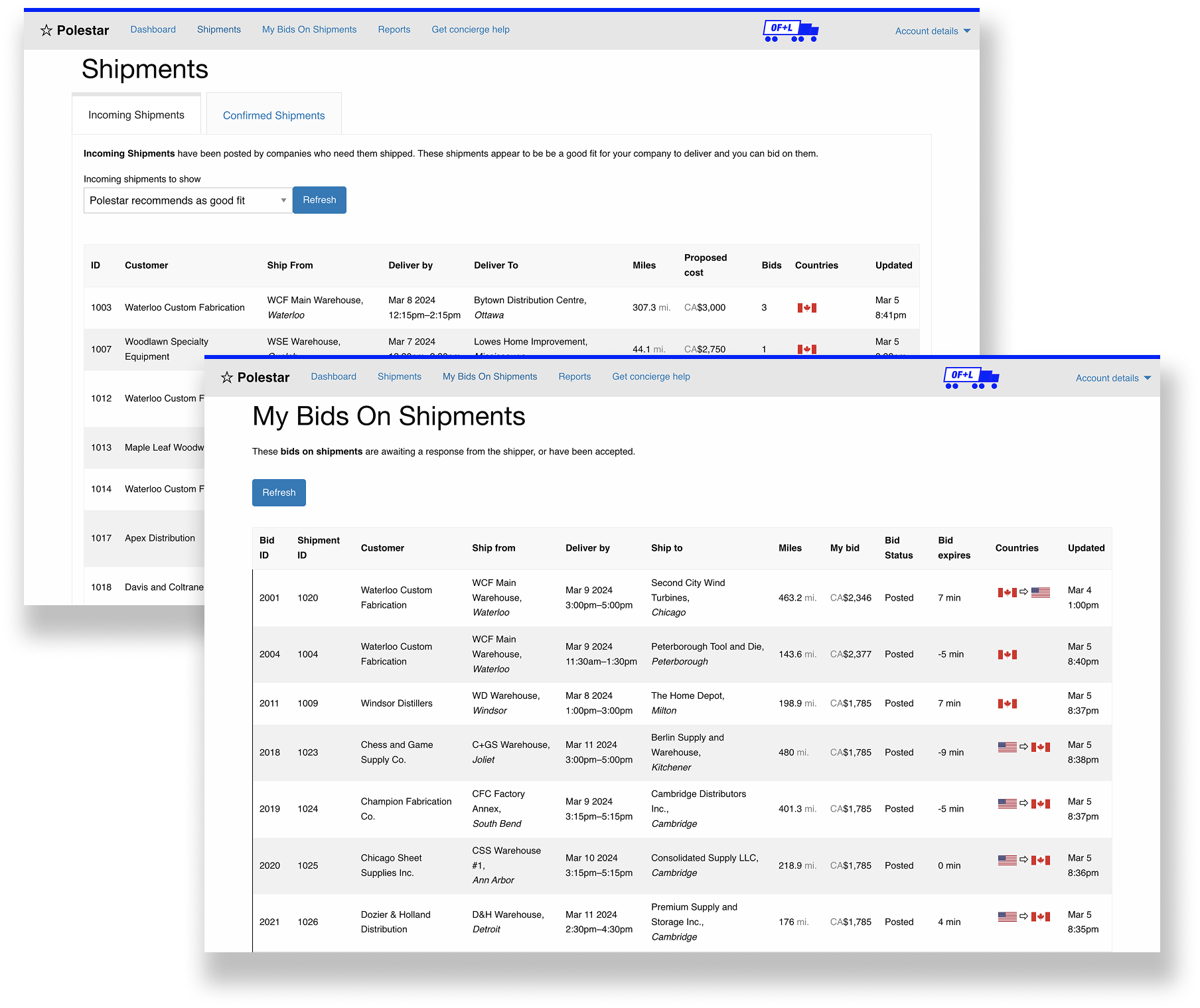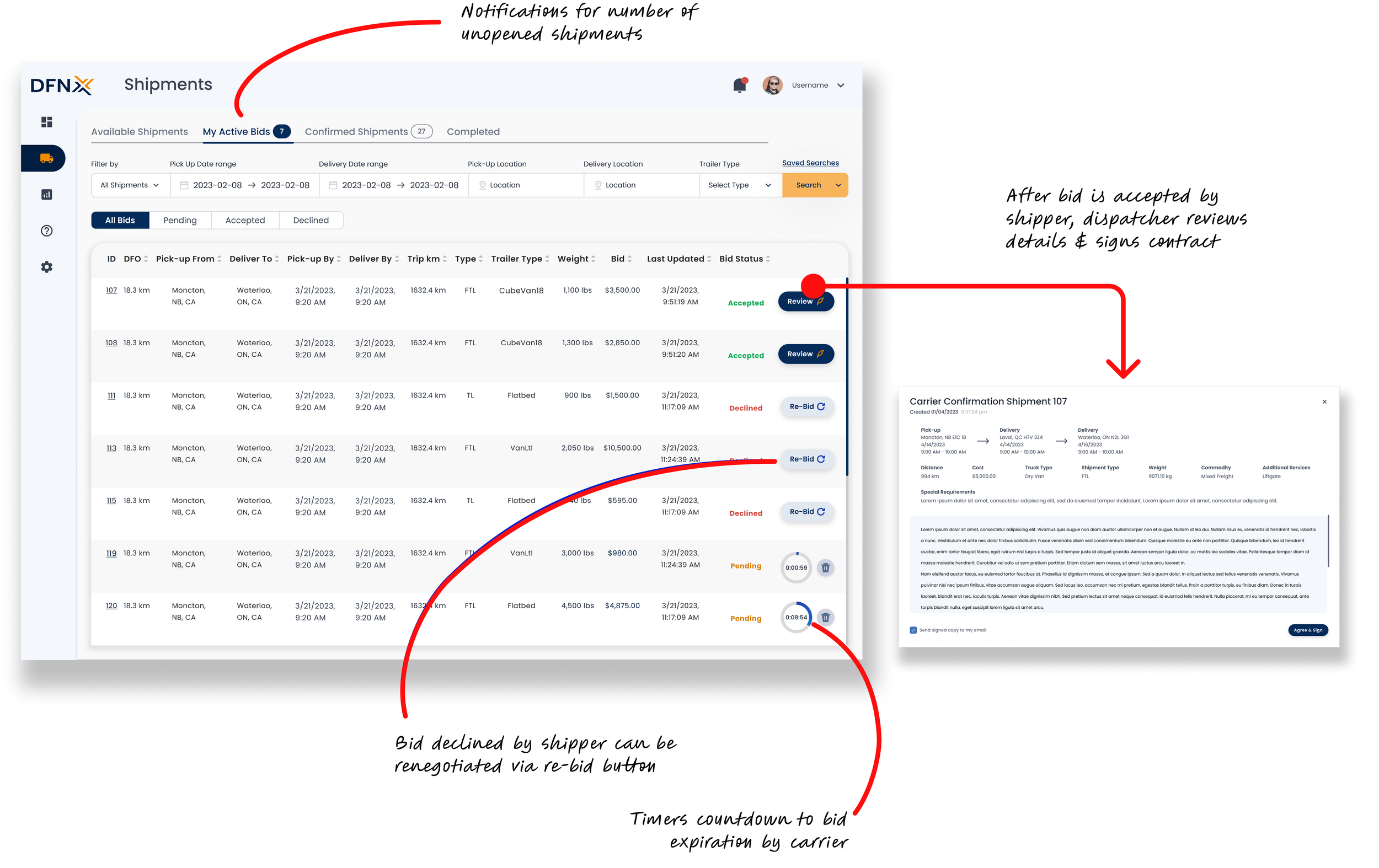DFNX Freight Exchange // 2023
MVP design for freight logistics platform
Role
Scoped and designed features for logistics marketplace platform (pre-launch)
Team
One of three designers, CTO, and in-house expert
Timeline
6 weeks
Traditionally, shippers (companies that ship products) rely on brokers to find carriers (companies that transport products). DFNX Freight Exchange aims to move this process online by connecting shippers and carriers directly.
Over six weeks, I collaborated with two designers, the CTO, and an in-house expert to conduct competitive analysis, design the carrier-side MVP, and strategize future product stages.
Our primary user is a dispatcher at a small trucking company (aka the carrier)
In his day to day, the dispatcher…
Finds shipment jobs for their company’s trucks
Tracks shipment deliveries
Manages a fleet of 10 to 30 truck drivers
Works in a fast-paced and data-dense environment.
The dispatcher’s user journey is tied to the shipment lifecycle on DFNX
(1) A shipper will upload a request to transport a product shipment on the DFNX platform
(3) If the shipper agrees, the dispatcher confirms the shipment via contract and assigns it to an available truck in his fleet
(4) The dispatcher monitors the shipment’s status and sends updates to the shipper
(5) Once the shipment is delivered, the truck driver uploads a proof of delivery document to the platform
(2) The dispatcher places on a bid on the request
(6) DFNX automatically disburses payment from the shipper’s account to the carrier
How might we help our dispatcher quickly prioritize and respond to shifting tasks as shipments moves through their lifecycles?
We focused on two key areas to support our dispatcher:
Switching between workflows: Dispatchers constantly toggle between bidding and tracking across dozens of shipments.
Speed and efficiency: Fast task completion is critical. Quick bidding helps win jobs and reduce empty trucks. Quick and efficient tracking improves communication and service for shippers.
The initial prototype did not address our dispatcher’s needs
Our team of designers were given a carrier-side prototype that failed to address the dispatcher’s needs. Our three key problem areas were: (1) confusing information architecture, (2) unclear affordances, and (3) buried/obscured information display.
Users would easily get lost in different pages, slowing down crucial tasks.
Competitive analysis of five platforms revealed key UI strategies
We analyzed 5 similar* logistics platforms and found reoccurring UI/features that we incorporated into our redesign:
Tabbed workflow to organize shipment lifecycle
Robust filtering to find bids and confirmed shipments
Strategic slide-in panel in crucial junctures of user journey
With these strategies in mind, our team set out its redesign of the carrier-side prototype.
*Compared to competitors, DFNX targeted smaller-sized carriers in a different geographic market
Improved navigation for easy access
In the prototype, bidding stages were spread across multiple pages and layers of the information architecture—resulting in an inefficient, disjointed experience.
In our new design, we implemented a tabbed workflow for easy access to shipments at each stage. Filters under each tab help locate specific shipments more easily.
Under “My Active Bids” and “Confirmed Shipments,” we added additional subcategories for more streamlined organization.
Clear affordances for quick task completion
In the prototype, shipments at different stages appear nearly identical and lack clear action cues.
For our design, we created distinct affordances for each stage of the shipment.
Maintaining context within workflow
Our dispatcher frequently switches workflows, so clarity is critical. However, the prototype buries key information and actions, leading to a confusing experience. To fix this, we employed slide-out panels for critical actions. The information is more efficiently laid out, and the dispatcher can maintain context.
We can observe this change in the bidding flow:
The redesigned bidding flow utilizes a slide-out that conveniently keeps information all on one screen.
Another example is in updating information for confirmed shipments.
The redesign more succinctly displays information. Buttons for critical actions like updating shipment status or reporting an issue are prominently displayed.
Usability testing reveals crucial directions for next-stage product
Our team created a new Figma prototype to conduct five usability tests using a mix of non-industry participants and logistics professionals. Alongside low-level UI fixes, we also uncovered five features for future versions.
High-priority features for better alignment with industry standards
(1) Saved searches accessed directly via link or auto-population in search bar. Dispatchers have set routes when looking for new shipments.
(2) Counter-offers and history rather than one re-bid for active bids. In the current brokerage market, carriers and shippers negotiate prices across multiple back-and-forth communications.
(3) Final cost calculation made post-delivery. Called “accessorials,” the initial agreed price does not include additional fees accrued while shipments are en route. Examples includes fees for equipment breakdowns, driver errors, and shipment delays.
Longer-term features for versions post-launch
(4) When bidding on shipments, carriers and shippers want to know service ratings. For an industry built on reputation, we suggested a feature to view and leave reviews on completed shipments.
(5) Tracking for truck availability helps dispatchers better calibrate bids. For example, inelastic supply (e.g. trucks have active shipments well into the future) allows dispatchers to bid higher. Since truck management is handled through external hardware, DFNX can offer integrations in the future.
Other case studies
HabitMeal (coming soon) // AI-enabled meal planning tool
Pynx.ai // Web3 news summarization tool
TrueMedia.org // Web app for deepfake detection






















